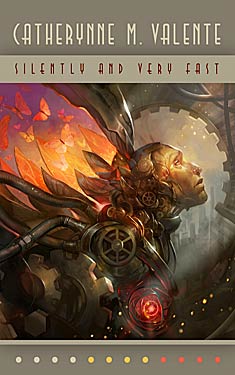RYO Review: Silently and Very Fast by Catherynne M. Valente

 I read the first few chapters of this novella as an act of faith, because Valente has earned my trust as a reader, and because Silently and Very Fast has an award and nomination list long enough to be its own short story (it won the Locus Award for Best Novella, and was nominated for the Hugo, Nebula, and World Fantasy awards). So I waded through dense cyber-fairytale imagery on the assumption that it would resolve itself into a story. It did. A very, very good one.
I read the first few chapters of this novella as an act of faith, because Valente has earned my trust as a reader, and because Silently and Very Fast has an award and nomination list long enough to be its own short story (it won the Locus Award for Best Novella, and was nominated for the Hugo, Nebula, and World Fantasy awards). So I waded through dense cyber-fairytale imagery on the assumption that it would resolve itself into a story. It did. A very, very good one.
It’s difficult to find the beginning of Silently and Very Fast; it’s one of those Ouroboros stories which loops and curls until it’s eating its own tail. At some point, it becomes clear that your narrator is Elefsis, a self-aware program that lives in the consciousness of the Uoya-Agostino family in a future version of Hokkaido. Elefsis is passed down through the generations in a surgically-implanted jewel, and each human mind she lives in teaches her more about emotion, humanity, creation, and symbolic representation. When the book begins, Elefsis has just been hastily transferred to a woman named Neva — the last surviving member of the family. Neva is tense and unhappy to be saddled with the family heirloom, and she keeps secrets tucked away in their shared dreamscape. Elefsis mines their internal consciousness (the Interior), and discovers more about the world outside them and her place in it.
 Interspersed with this quasi-linear plot are short stories which are roughly what would happen if a machine got ahold of some Brothers Grimm and ran wild (the Uoya-Agostinos have apparently been telling Elefsis some bedtime stories, over the years). Readers of Valente will know that Valente likes fairy tales. Or, more accurately, that Valente’s brain is so saturated with fairy tales that her writing as a whole is an extended conversation about the beautiful and terrible power of stories — of princesses sleeping in glass coffins, evil stepmothers, two children who go into the dark woods, sons who quest after their fathers — and the wonderful things that happen when we rewrite them.
Interspersed with this quasi-linear plot are short stories which are roughly what would happen if a machine got ahold of some Brothers Grimm and ran wild (the Uoya-Agostinos have apparently been telling Elefsis some bedtime stories, over the years). Readers of Valente will know that Valente likes fairy tales. Or, more accurately, that Valente’s brain is so saturated with fairy tales that her writing as a whole is an extended conversation about the beautiful and terrible power of stories — of princesses sleeping in glass coffins, evil stepmothers, two children who go into the dark woods, sons who quest after their fathers — and the wonderful things that happen when we rewrite them.
It is therefore unsurprising that these interspersed stories were some of my very favorite parts. I was especially taken by the retelling of Sleeping Beauty, where humanity is the King and Queen and their baby princess is Artificial Intelligence. When we made sentient machines for the first time,
…a great celebration was called, and humanity invited all the Fairies of its better nature to come and bless the child with goodness and wisdom. The Fairy of Self-Programming and the Fairy of Do-No-Harm, the Fairy of Tractability and the Fairy of Creative Logic, the Fairy of Elegant Code and the Fairy of Self-Awareness…but one Fairy had been forgotten, or perhaps deliberately snubbed, and this was the Fairy of Otherness.
And we all know that the forgotten Fairy has an inordinate amount of sway in these situations, and the Fairy of Otherness casts her curse. This story, and the others, are all deftly woven into the bigger fairy tale in Silently and Very Fast: the story about machines turning on men. It’s a much newer narrative than the others, but it goes something like this: Man creates machines “in his own likeness,” machines grow self-aware and rather resentful, machines inevitably rise up to destroy us, a la Battlestar Galactica, Terminator, The Matrix, Blade Runner, and all of science fiction. (But of course, this isn’t a new story, is it? The hardware has changed, but the slave-who-turns-on-his-master story has to be as old as masters and slaves, which is very old indeed). There are always Good Robots in these stories, though, who want to do things like Learn to Love and be human and ask questions like “Why is salty water coursing down my cheeks? What is this thing you call love?” They end up as smashed piles of spark plugs pretty often, but sometimes they do okay.
But Valente never lets a narrative walk away from the scene of the crime. She retells the robot-master story, except that Elefsis is neither an omnipotent robot overlord, nor a good robot trying to learn how to be human. Well, maybe she’s trying to learn to be human, but it’s a process that looks suspiciously like a child learning to be human. She copies the Uoya-Agostinos’s gestures and behaviors. She worries (“worrying is defined as obsessive examination of one’s own code”) that she has never done anything that wasn’t an act of “careful, exquisite mimicry.” But then she wonders, “Have they?” Humans are the cleverest of evolutionary copy-cats, after all.
Ultimately, though, Elefsis doesn’t want to be human:
To tell a story about a robot who wants to be human is a distraction. There is no difference. Alive is alive. There is only one verb that matters: to be.
It’s this constant examination of human-ness and machine-ness, and the significance of story-telling to both of those things, which makes this such a compelling read. So, have faith. Wander through the first dizzying chapters — get yourself three-quarters lost in the bizarreness of dreamscapes made up of symbols layered on imagery piled on the pure fantastic — and get to the meat of the story.
This review was originally published at Fantasy Literature.



















 Full Details
Full Details


No comments yet.
Sorry, the comment form is closed at this time.